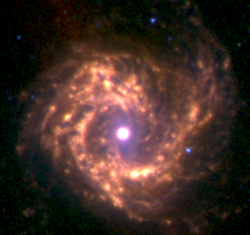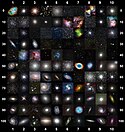Spiral arms of M61 hubble april 2021
Though the gleaming spiral of this galaxy makes for a spectacular sight, one of the most interesting features of M61 lurks unseen at the centre of this image. As well as widespread pockets of star formation, M61 hosts a supermassive black hole more than 5 million times as massive as the Sun.
M61 appears almost face-on, making it a popular subject for astronomical images, even though the galaxy lies more than 52 million light-years from Earth. This particular astronomical image incorporates data from not only Hubble, but also the FORS camera at the European Southern Observatory’s Very Large Telescope, together revealing M61 in unprecedented detail. This striking image is one of many examples of telescope teamwork — astronomers frequently combine data from ground-based and space-based telescopes to learn more about the Universe.Relevante Bilder
Relevante Artikel
Messier 61Messier 61 = NGC 4303 ist eine Spiralgalaxie vom Hubble-Typ SABbc im Sternbild Jungfrau auf der Ekliptik. Sie ist schätzungsweise 66 Millionen Lichtjahre von der Milchstraße entfernt und hat einen Durchmesser von etwa 100.000 Lj. Die Entfernungsmessungen basierend auf den Radialgeschwindigkeiten stimmen nicht mit den rotverschiebungsunabhängigen Entfernungsschätzungen von 48 ± 24 Millionen Lichtjahren überein. M61 gehört zu den größeren Spiralgalaxien des Virgo-Galaxienhaufens, einer Ansammlung von Galaxien, die alle durch ihre gegenseitige Anziehungskraft zusammengehalten werden. .. weiterlesen





